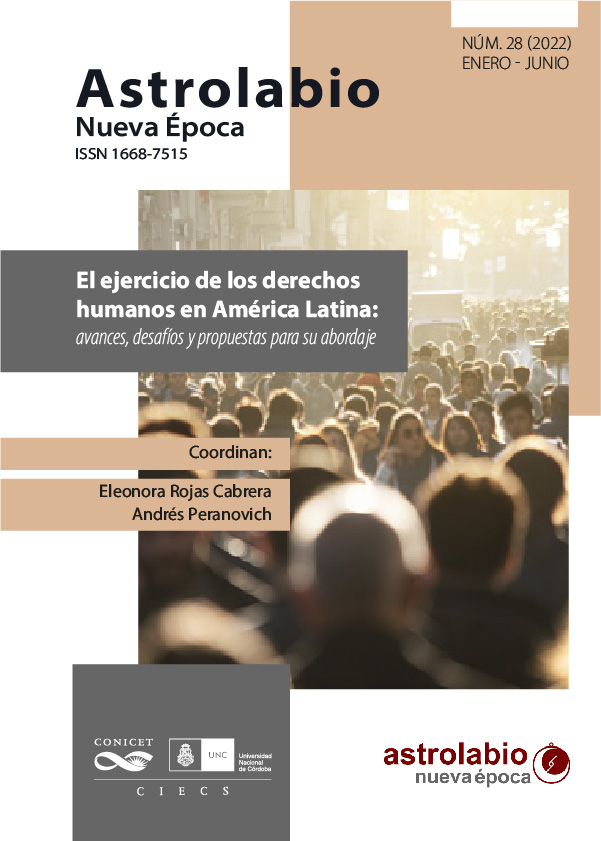The formation of the latin american video movement: conditions, agents and speeches
Main Article Content
Abstract
This article addresses the phenomenon of the Latin American Video Movement, which was a network of heterogeneous experiences whose founding act was formalized in December 1987 within the framework of the IX International Festival of New Latin American Cinema in Havana. The Movement functioned as a space for sub-continental dialogue and integration concerned with: establishing cooperative relationships and avoiding the atomization of experiences, promoting the development and organization of national groups in pursuit of democracy, improving and increasing the flow of information and circulation of productions, systematizing current projects, socializing partial learning, and generating training mechanisms.
As part of a broader investigation, where the Network's path between 1987 and 1992 —the last year of formal existence— is exhaustively reported, this work focuses on the analysis of the material, discursive and cultural conditions that made its emergence possible, to then examine in detail its first year of life, taking into account the different instances of dialogue substantiated by the regional filmmakers.
Downloads
Article Details

This work is licensed under a Creative Commons Attribution-NonCommercial-ShareAlike 4.0 International License.
Astrolabio, Nueva Época está protegida bajo licencia Licencia Creative Commons Atribución-NoComercial-CompartirIgual 4.0 Internacional. La propiedad intelectual de los artículos pertenece a los autores y los derechos de edición y publicación a la revista. Los artículos publicados podrán ser usados libremente para propósitos científicos y académicos, siempre y cuando se realice una correcta citación de los mismos. Cualquier persona física o jurídica que desee reimprimir parte o la totalidad de algún artículo, deberá obtener permiso escrito de los editores de Astrolabio Nueva Época, quien lo otorgará con el consentimiento del autor.
References
AUFDERHEIDE, Patricia. (1990). “Latin American cinema and the rhetoric of cultural nationalism: Controversies at Havana in 1987 and 1989”. Quarterly Review of Film and Video, 12-4, 61-76.
BURKE, Peter. (1996). Obertura: la nueva historia, su pasado y su futuro. En Peter Burke (ed.), Formas de hacer historia, pp. 11-37. Barcelona: Alianza.
BURKE, Peter. (2006). ¿Un nuevo paradigma? En ¿Qué es la historia cultural?, pp. 69-96. Buenos Aires: Paidós.
DE LA FUENTE, Alejandro y GUERRERO, Claudio. (2018). Comunicación y democracia: treinta años del Primer Encuentro Latinoamericano de Video Alternativo (Santiago 1988). En Lucía Rodríguez Riva y Dana Zilberman (comps.), Intensidades políticas en el cine y los estudios audiovisuales latinoamericanos: identidades, dispositivos, territorios. Actas del VI Congreso Internacional AsAECA, pp. 312-325. Buenos Aires: AsAECA-Digital.
DINAMARCA, Hernán. (1990). El video en América Latina. Montevideo: Centro de Estudios Audiovisuales y Fundación de Cultura Universitaria.
GETINO, Octavio. (1985). La importancia del video en el desarrollo nacional. En AA. VV., Video, cultura nacional y subdesarrollo - Ponencias presentadas en el VI Festival Internacional del Nuevo Cine Latinoamericano de La Habana. Diciembre de 1984, pp. 25-35. México: UNAM.
GETINO, Octavio. (1990). “Video popular en América Latina”. Chasqui. Revista Latinoamericana de Comunicación, 33, 60-68.
GETINO, Octavio. (1996). La tercera mirada. Panorama del audiovisual latinoamericano. Buenos Aires: Paidós.
GUMUCIO DAGRON, Alfonso. (1989). “Hacia Cochabamba Video 1989”. Boletín RED de Recursos de Comunicación Alternativa, 22, 1.
GUTIÉRREZ, Mario (ed.). (1989). Video, tecnología y comunicación popular. Perú: IPAL y Crocevia.
LIÑERO, Germán. (2010). Apuntes para una historia del video en Chile. Santiago de Chile: Ocho Libros.
LOBETO, Claudio. (2009). Entre la acción social y las prácticas estéticas: el movimiento de video en Santiago de Chile, San Pablo y Buenos Aires (1980-2000). Tesis de Doctorado en Filosofía y Letras. Facultad de Filosofía y Letras, Universidad de Buenos Aires.
MONDACA RAITERI, Hermann (2019). Historia del Movimiento de Video Alternativo en Chile en el período 1980 a 1990 y su relación con los Medios de Comunicación. (Material inédito cedido gentilmente por el autor en la fecha indicada.)
ONORATI, Antonio. (1989). La cooperación intra e inter-regional. En Mario Gutiérrez (ed.), Video, tecnología y comunicación popular, pp. 67-80. Perú: IPAL y Crocevia.
RONCAGLIOLO, Rafael. (1989). América Latina: las Comunicaciones en el año 2000. En Mario Gutiérrez (ed.), Video, tecnología y comunicación popular, pp. 35-49. Perú: IPAL y Crocevia.
SANJINÉS, Jorge. (1987). “Un Festival para la historia del cine”. Revista Imagen, 2. 43-46.
TADEO FUICA, Beatriz y BALÁS, Mariel (eds.). CEMA: archivo, video y restauración democrática. Montevideo: FIC-UdelaR, ICAU.
Documentos colectivos
Manifiesto de Santiago. En Ricardo Gómez (ed.), Puntadas para un sueño. El Movimiento de Video en Colombia y América Latina, pp.63-69. Bogotá, Ricardo Gómez Editor y Videcombo, 1993. (Edición original, 1988.)
Declaración de San José. En Mario Gutiérrez (ed.), Video, tecnología y comunicación popular, pp. 227-229. Lima, IPAL y Crocevia, 1989. (Edición original, 1988.)
Documento final: Seminario Experiencias de Video en América Latina. Revista Imagen, 5, 1988-1989, 28-29.
Segunda Declaración de La Habana. “Video Latinoamericano: Avances y Desafíos”. Revista Imagen, 6, 1989, 42-44.

